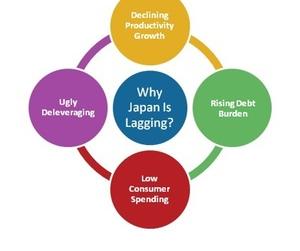Ray Dalio’s Economic Principles: Why Is Japan Still Lagging?
Reviewing Ray Dalio’s economic principles template is helpful to understand the situation in Japan. It’s important to understand Japan’s challenges.
Sept. 23 2015, Published 11:17 a.m. ET

Japan—an example of the economic principles at work
Japan has been in the headlines due to its credit rating downgrade. Standard & Poor’s recently downgraded Japan’s sovereign debt to A+. It cited weak economic growth among the reasons for the downgrade. A rating downgrade does prompt investors to take a fresh look at the country’s key economic indicators. Reviewing Ray Dalio’s economic principles template is helpful, How the Economic Machine Works in 30 Minutes. In Japan’s case, his principles are appropriate to understand the situation.
Let’s look at Japan’s case in conjunction with Dalio’s macroeconomic principles. It will help you understand what the country has and continues to experience.
Why Japan is still lagging
While Dalio’s presentation is a treasure trove of information and logic, especially for macroeconomic enthusiasts, we’ll restrict the scope of this series to four key areas and to Japan.
- Spending drives the economy
- Productivity growth matters most in the long run
- Debt is an important driver of economic swings
- Japan is undergoing a rough deleveraging
Japan’s “ugly deflationary deleveraging” process
We’ll start by taking a look at the state of consumer spending in Japan. According to Dalio, spending is the driving force behind any economy. We’ll elaborate on this more throughout this series. We’ll also discuss the productivity growth in Japan as well as its debt situation.
Japan is the most indebted economy in the world. Its debt is close to 230% of its GDP (gross domestic product). In Dalio’s words, it has been stuck in an “ugly deflationary deleveraging” process for over two decades. The economy is marred with a deflationary environment, weak growth, and a rising debt burden.
Stock markets have risen
However, Japan’s stock markets did seem to break the spell. The Nikkei 225 Index measures broad market performance in Japan. It tracks the 225 top rated companies listed on the Tokyo Stock Exchange. It rose from a sub 10,000 level in 2012 to an over 20,000 level in June and July 2015.
The Prime Minister’s, Shinzo Abe, “three arrows” seemed to have helped the stock markets rise in Japan by relative currency devaluation. The Japanese yen has depreciated from the time that Abe took office in December 2012. The currency has depreciated by about 50% since then. The iShares MSCI Japan (EWJ) rose over 32% since then as of September 18, 2015. The WisdomTree Japan Hedged Equity ETF (DXJ) has gained about 50%. Japanese exporters like Sony (SNE), Toyota Motor (TM), and Honda Motor (HMC) have gained from the currency devaluation.
Let’s start examining the four issues mentioned above in order to understand what Japan is facing.
